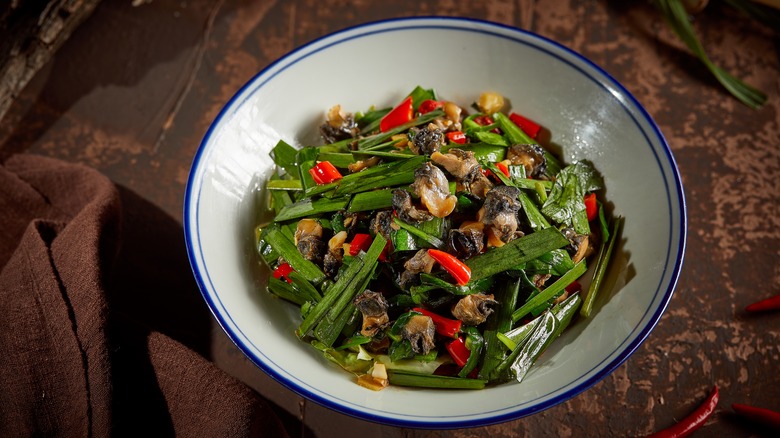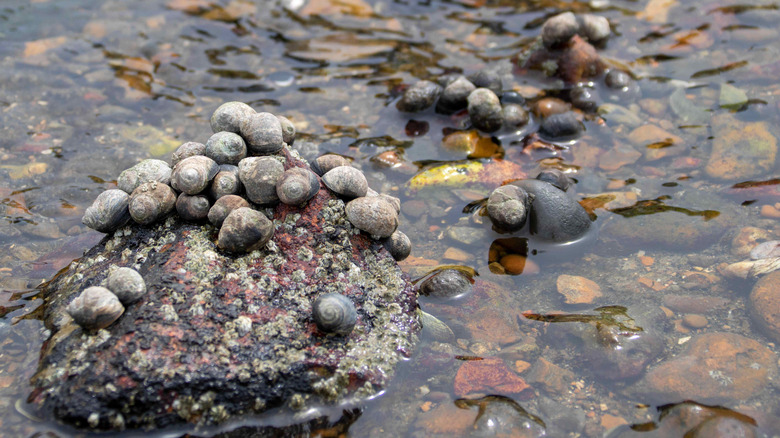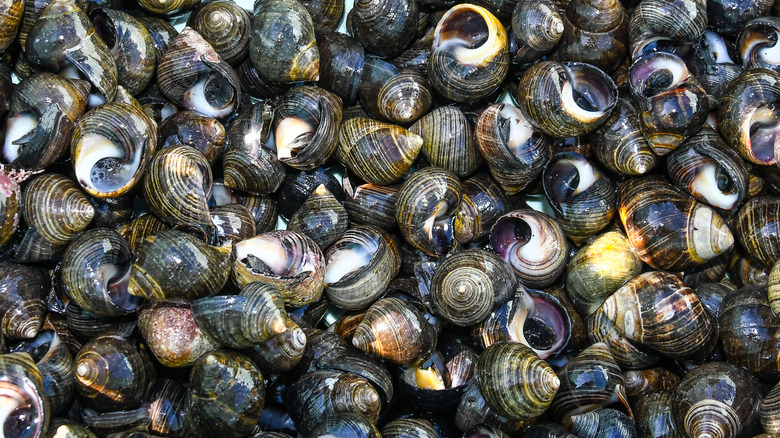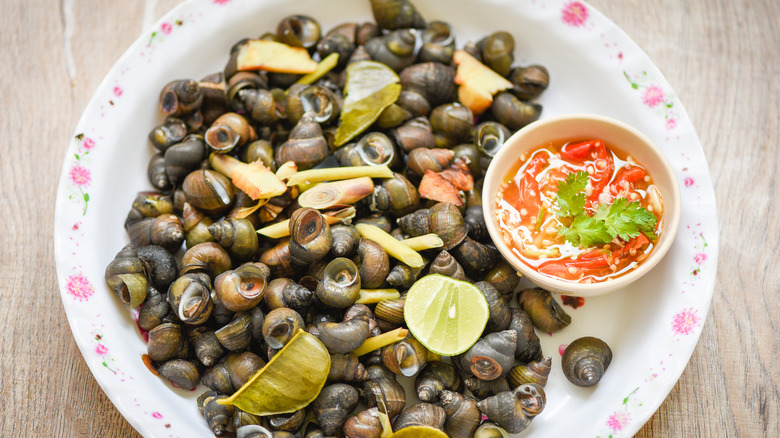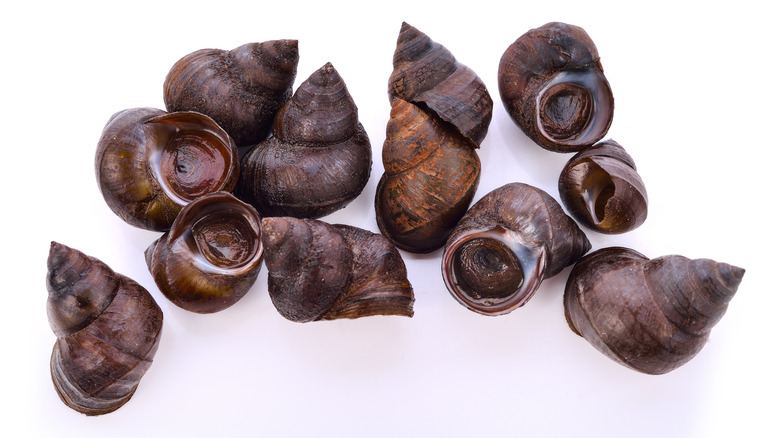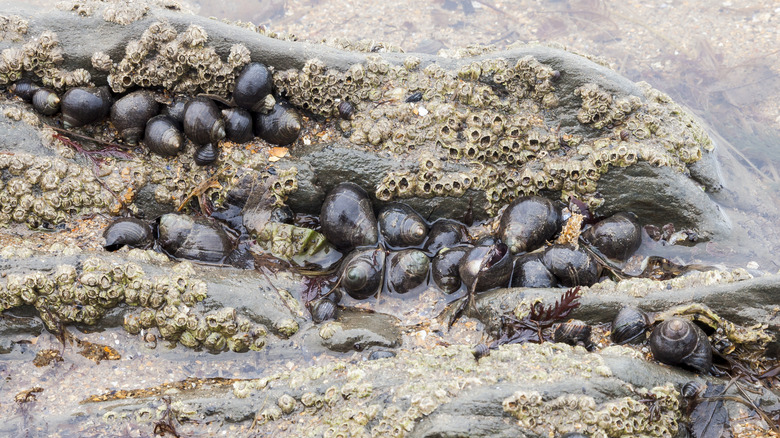What Is Periwinkle Meat And How Do You Eat It?
While a shade of purplish-blue or a flowering plant may first come to mind when you hear the word, periwinkles (littorina littorea) are a tiny, edible sea snail. A longtime staple seafood in England, also referred to as winkles, they were typically deemed food for the poor and commoners. The name stems from the Old English word "pnewincle."
Periwinkle meat is quite common in Europe, and even considered a delicacy in Asian and African cultures, but it is rarely seen on the menu in the United States. Essentially, periwinkles are the escargot of the U.K., introduced to North America in the mid-1800s when brought over, most likely attached to ships from Europe. They can now be found along the coastline, but their popularity never seemed to take off in North America.
There are a myriad of ways to enjoy periwinkle meat. Whether simply steamed, bathed in butter or stir-fried Cantonese style, the little guys are known for being full of flavor with a delicate texture.
What are periwinkles?
The sea snails are considered an invasive species of shellfish, meaning there are no laws surrounding capturing them and no risk of overharvesting. They are small, averaging between 1/4 to 1/2 an inch in size. There are a variety of species of periwinkles: Small Periwinkle, Flat Winkle, Edible Periwinkle, and Rough Winkle. The Edible Periwinkle is so named because it is the largest, worth the effort to wrangle the meat out of its shell, averaging about an inch in size. Their shells are spiraled and take on a rounded pyramid shape, somewhat similar to a Hershey's Kiss. The colors of their shell run the gamut — from black to yellow, to blue, to cream colored or olive green.
Periwinkles live along the shoreline, where the ocean meets land between the tides. They have a foot that suctions onto rocks or docks, and can be found in mud or sand. They feed on algae and marsh grass and the occasional small organism, egg, or larvae. Periwinkles are a source of nourishment for crabs, fish, and birds, and have a unique built-in mechanism to their shell to keep them moist. Almost like a little trap door, they have a scale that opens and closes, letting water in and out while protecting their meaty body.
What does periwinkle meat taste like?
The taste of periwinkle meat is often likened to soft-shelled steamer clams, but with a more delicate and tender texture. Their flesh is salty with the hint of sweetness of a west coast oyster, and meaty like a clam. They are often used as a substitute for clams in certain dishes due to the similarities. Some people detect notes of lobster.
All parts of the sea snail's body are edible except for the foot that it uses to attach to rocks. It can be discarded after cooking. Like its shell, the body is spiraled and comes out in one piece with a curled tail. Their meat becomes tough and rubbery if overcooked, but if prepared properly the texture is soft and delicate. Periwinkle meat is not safe to be consumed raw, but because of its diminutive size, it cooks up in a matter of minutes.
How to enjoy periwinkle meat
Before enjoying periwinkle meat, you have to get it out of the shell. A lot of work goes into prepping the sea snails without much of a return on that investment of time. Apparently, New Englanders are taught at a young age to hum to the little creatures in order to coax them out. If you're not the best at carrying a tune, another option is to cook them and use a toothpick or small fork to wriggle the meat out, or simply suck it out and enjoy.
Because of their size and the effort to get out what is ultimately a tiny bite of meat, periwinkles are often served as an appetizer. The easiest method to prepare them is to boil them anywhere between 3 and 10 minutes, keeping in mind the longer you boil them the tougher they'll get. They are often served with vinegar or melted butter. You can remove them from their shells and save your guests some leg work.
Periwinkles are great in chowders or sautéed with black bean sauce for the classic Cantonese style version. You can also bathe and broil them in butter and garlic and top with fresh parsley for escargot. The dish is usually made with land snails, as they are larger, but given the similarities in taste and texture, they are interchangeable.
Other common flavor and spice pairings with periwinkle meat include bacon, chili, coriander, fennel, garlic, herbs, lemon, tomato, and white wine.
Where to find periwinkle meat
There are few places you can find periwinkle meat, and they mostly depend on where in the world you are located. In Europe, where periwinkles are native, they're widely available in fish shops. In the United States, they are harder to come by, but may be available to special order from specialty shops or online seafood producers. In larger cities along the northeast coast of the U.S., they may be easier to get. They are also sold packaged and frozen at some retailers.
There is the option to harvest them yourself, if you reside along the Atlantic or northern European coastline. It's as easy as just plucking them off whatever their foot is attached to and dropping them in a container. There is no risk of over-harvesting, so have at it.
Before cooking them, you need to give them a rinse in cold water and discard any that might be dead — if their little trap door is open, that indicates it's not alive. If you find them in a market where they're available in a tank by bulk, keep an eye out for the open trap door as well. You can give it a poke — if it doesn't close, the periwinkle is dead. They will also most likely emit a terrible smell.
Nutritional benefits of periwinkle meat
Despite their small size, periwinkle meat (and all snail meat) is packed with nutritional value. The protein content of their flesh rivals pork and beef but minus the fat, according to WebMD. Periwinkle meat is a great source of iron, calcium, vitamin A, and other minerals, as well as omega-3 fatty acids, just like their finned fish friends. Just one serving (roughly four ounces) contains almost a quarter of the recommended daily allowance of iron. Snails were used for medicinal purposes in medieval times, believed to treat tuberculosis and other common ailments.
It's important to properly cook the snails. If consumed raw, they come with serious complications. Parasites can make their way into snails and ultimately cause infection. But as long as they are cooked all the way through, you should be good to try a most unusual, healthy treat, straight from the ocean to your table.
